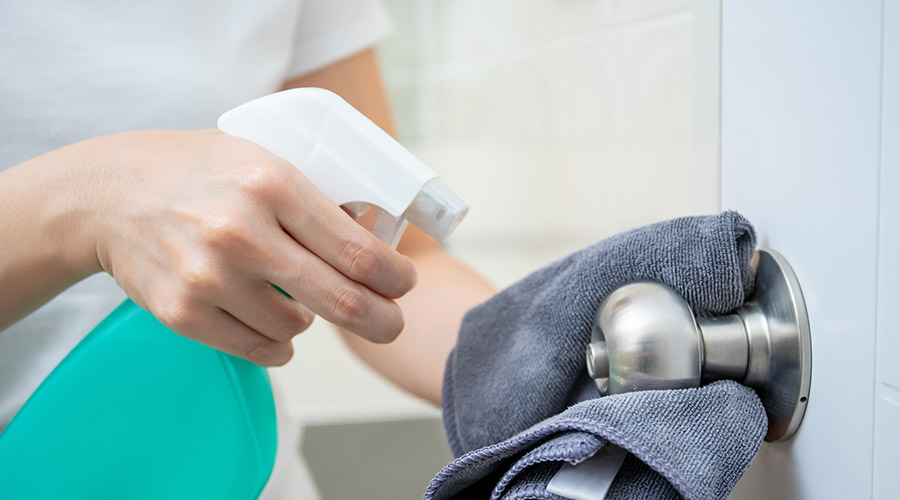“Any system, if left unattended or isolated, will eventually result in entropy. Or chaos.” - Jessica Brody, “The Chaos of Standing Still”
A dilution-control system automatically mixes a concentrated chemical with water to make a ready-to-use solution that is generally dispensed into a spray bottle or mop bucket.
Overuse of chemicals does not just create poor chemistry performance. It also introduces more chemicals into daily environments. Concentration- and dilution-control devices can save money, reduce environmental impact and increase worker safety.
A dispensing system must enable accurate and efficient dispensing. This system should prevent leaks, spills, drips and workplace contamination, while also protecting environmental services technicians. It also should eliminate costly mixing, measuring and dispensing mistakes by untrained personnel. Jan/san distributors say closed-loop chemical dispensing systems do just that.
There is evidence that using chemical disinfectants with concentrations that deviate from the product’s label recommendations can harm patients by compromising disinfection efficacy or causing unintended health effects.
Compromised efficacy, increased risk
Studies have shown that when disinfectants are diluted below the recommended concentration, their ability to kill pathogens is significantly diminished. For example, automated disinfectant dispensers in hospitals often deliver lower-than-expected concentrations, with some products having undetectable concentrations of disinfectant.
This situation can lead to inadequate disinfection and increased risk of healthcare-associated infections, such as those caused by Clostridioides difficle (C. Diff.) or methicillin-resistant Staphylococcus aureus (MRSA).
When environmental services (EVS) managers have neglected to establish that the hospital-approved disinfectant is being dispensed according to the product’s label, the potential for patient harm is very real.
Legal and regulatory implications
Using disinfectants outside the conditions specified on their EPA-registered labels not only can reduce their effectiveness. It also can expose users to liability for injuries or enforcement actions under the Federal Insecticide, Fungicide, and Rodenticide Act.
Improper dilutions of disinfectants can lead to patient infections. The exact frequency is not explicitly stated in the search results, but several studies and findings highlight the prevalence and risks associated with this issue.
In a review of publications on disinfection failure incidents, almost 90 percent of cases where a pathogen was isolated did not determine its susceptibility to the disinfectant used. When assessed, the pathogen in most cases was highly resistant to the disinfectant, suggesting resistance plays a significant role in disinfectant failures.
To prevent potential issues with the improper dilution of concentrated cleaning and disinfectant products, quality control testing should be conducted as part of a preventive maintenance program.
This process includes the use of chemical indicator strips or test strips. These strips are intended to indicate whether there might be an obvious dispensing issue, such as water quality, water pressure or proportioning tip malfunction. It is important to clarify that these strips are not pass/fail and therefore are not absolute. The color coding also means the results might be subjective.
Managers should engage their disinfectant vendors and suppliers in a periodic validation of the accuracy of the dilution control center. Managers looking for an idea for a 2025 EVS quality assurance program should consider making the accuracy of in-use disinfectants a high priority.
J. Darrel Hicks, BA, MESRE, CHESP, Certificate of Mastery in Infection Prevention, is the past president of the Healthcare Surfaces Institute. Hicks is nationally recognized as a subject matter expert in infection prevention and control as it relates to cleaning. He is the owner and principal of Safe, Clean and Disinfected. His enterprise specializes in B2B consulting, webinar presentations, seminars and facility consulting services related to cleaning and disinfection. He can be reached at darrel@darrelhicks.com, or learn more at www.darrelhicks.com.

 Contaminants Under Foot: A Closer Look at Patient Room Floors
Contaminants Under Foot: A Closer Look at Patient Room Floors Power Outages Largely Driven by Extreme Weather Events
Power Outages Largely Driven by Extreme Weather Events Nemours Children's Health Opens New Moseley Foundation Institute Hospital
Nemours Children's Health Opens New Moseley Foundation Institute Hospital Code Compliance Isn't Enough for Healthcare Resilience
Code Compliance Isn't Enough for Healthcare Resilience Ribbon Cutting Marks First Phase Completion for New Montefiore Einstein Facility
Ribbon Cutting Marks First Phase Completion for New Montefiore Einstein Facility